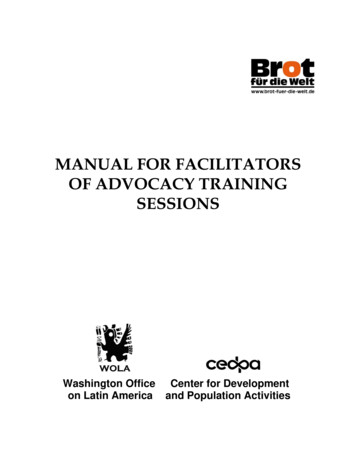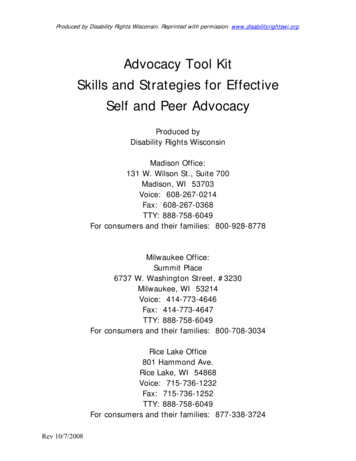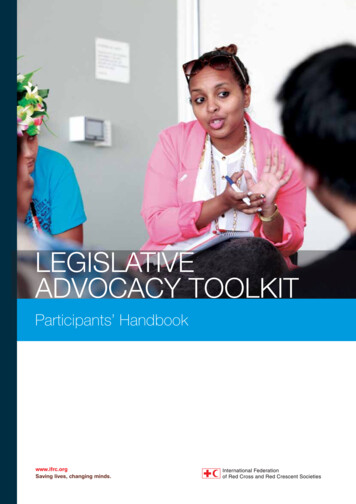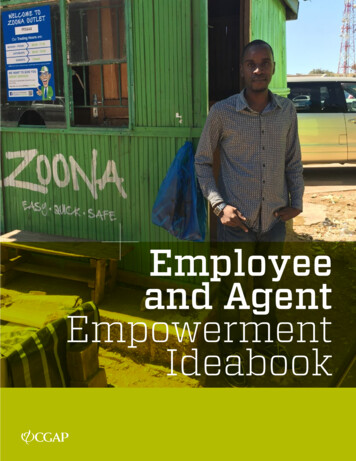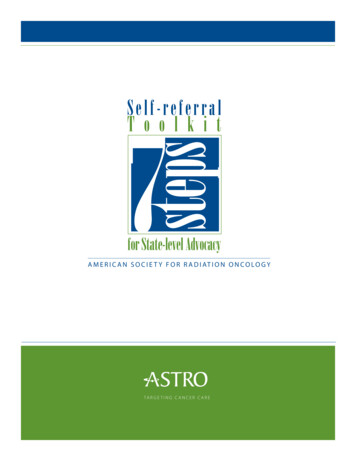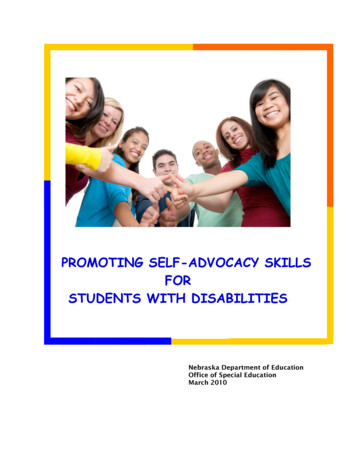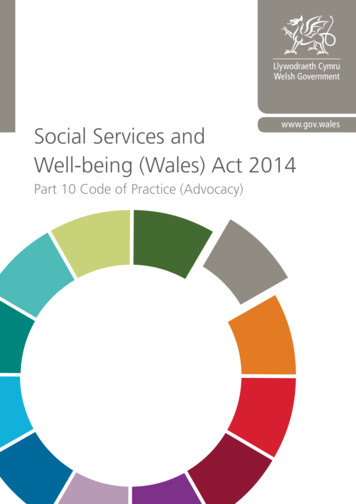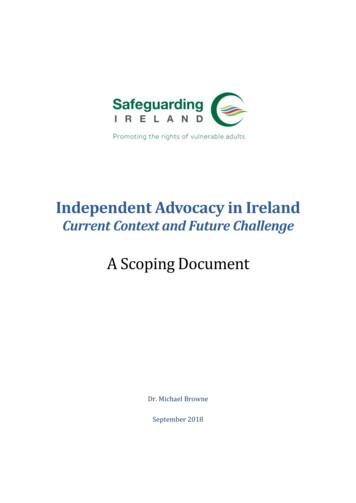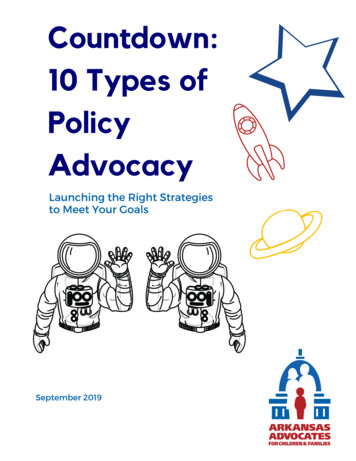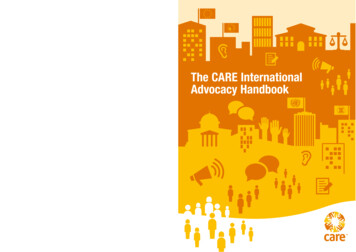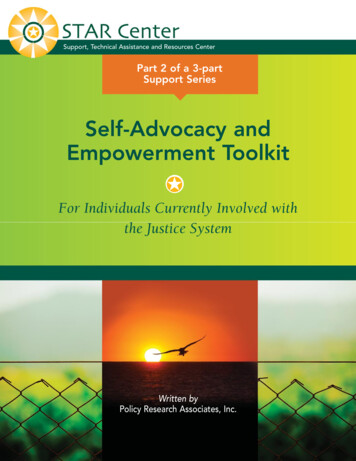
Transcription
Support, Technical Assistance and Resources CenterPart 2 of a 3-partSupport SeriesSelf-Advocacy andEmpowerment ToolkitFor Individuals Currently Involved withthe Justice SystemWritten byPolicy Research Associates, Inc.
Copyright 2012The National Alliance on Mental Illness (NAMI)3803 N. Fairfax Dr., Suite 100, Arlington VA 22203www.nami.orgHelpLine: (800) 950-NAMI (6264)Twitter: NAMICommunicateFacebook: www.facebook.com/officialNAMIStock photos used in this publication are not meant to indicate any particular attitude or opinion on the part ofthose whose images are being used and are not intended to indicate an endorsement by the subjects.The NAMI STAR Center is a SAMHSA-funded technical assistance center dedicated to promoting and enhancingrecovery, mental health, and wellness through information, training, and resources on effective self-help andmulticultural competence and social inclusion approaches with a special focus on working with mistarcenterThe STAR Center gratefully acknowledges SAMHSA as the funding sourcefor the STAR Center’s work and activities.Please visit SAMHSA/CMHS at www.samhsa.gov for many helpful resources,self-help tools, guides and links.The views and opinions presented in this document do not necessarily reflect those of SAMHSA orthe U.S. Department of Health and Human Services and should not be construed as such.NAMI’s STAR Center would like to acknowledge PolicyResearch Associates (PRA), operators of SAMHSA’s GAINSCenter, and the following PRA/GAINS Center staff whoauthored and edited this publication:STAR Center Staff:LaVerne D. Miller, JDLatrease Moore, MSChanson D. Noether, MAMatthew CanutesonSamantha Califano, MSStephen Kiosk, M.Div., LPCDirectorPhilip Qualo, J.D.Program Manager
Support, Technical Assistance and Resources CenterPart 2 of a 3-partSupport SeriesSelf-Advocacy andEmpowerment ToolkitFor Individuals Currently Involved withthe Justice SystemWritten byPolicy Research Associates, Inc.
The JourneyYearning for searching for and asking why?The struggle to find the answers ran wild.Then I stopped and asked and then I heard I am here.I have always been here and I will always take care of you.For so long what I have searched for I found HopeThis small word with such enormous meaning Has been the light that guides me on my journey ofAcceptanceForgivenessHealing and RecoveryBy Tracy C. LovePublished with Permission from the AuthorAcknowledgementsEach recovery journey begins with just one step and we hope Learning About Us, Learning to Help Us:Supporting People with Psychiatric Disabilities in the Criminal Justice System will help you assist people asthey begin and progress through their recovery journeys. Developing this guide was truly a collaborativeeffort and we were driven throughout the process by the conversations we had with the consumers whoplayed an indispensable role in its development.Whether it was someone experiencing his or her first contact with the police or someone looking foremployment upon release from a long period of incarceration, their strength and optimism truly inspiredthis guide’s creation. Most importantly, the consumers who provided input made us even more aware ofthe types of resources and supports that are the most helpful to people in their recovery processes.We would like to extend our heartfelt thanks to the dozens of justice-involved consumers who shared theirrecovery journeys with us. They shared their challenges and successes in an effort to ensure that this guidewas developed by people who know the most about the true predicament of justice-involved consumersin our country consumers themselves.For this project, members of this largely invisible community chose to break their silence to bring amessage of hope to others, many times sharing painful experiences. In so doing, they picked hope overfear, success over failure and forgiveness over anger.Lastly, we thank the members of the Advisory Committee for providing invaluable support and guidancefor this project; without their leadership, none of this would have been possible.
Table of ContentsIntroduction. . . . . . .Services.Self-helpand Peer.SupportWhy Assess Your Program’s Cultural Competency . . . . . . . . . . . . . . . . . . . . . . . . . . . . . . . . . . . . . .Basic Definitions. . . Recovery. . . . . . . .Tools.Self-explorationTools .andHow to Use This Tool . . . . . . . . . . . . . . . . . . . . . . . . . . . . . . . . . . . . . . . . . . . . . . . . . . . . . . . . . .WellnessHowToolsThis Tool Was Evaluated . . . . . . . . . . . . . . . . . . . . . . . . . . . . . . . . . . . . . . . . . . . . . . . . . . . .24225346Focus Area Approaches1: Administration,Policies and GuidelinesAlternativeto Wellness8Why Does This Matter? . . . . . . . . . . . . . . . . . . . . . . . . . . . . . . . . . . . . . . . . . . . . . . . . . . . . . . . . 5CommunityWhereConnections:Do We Look? Housing,. . . . . . . .Employment/. . . . . . . . . . .Education,. . . . . . . . .Voting. . . . . .Rights. . . . . . . . . . . . . . . . . . . . . . . . 59What Are Next Steps for Our Action Plan? . . . . . . . . . . . . . . . . . . . . . . . . . . . . . . . . . . . . . . . . . 6Understanding the Behavioral Health System10Bright Idea! . . . . . . . . . . . . . . . . . . . . . . . . . . . . . . . . . . . . . . . . . . . . . . . . . . . . . . . . . . . . . . . . 7Try This!. . . . . Model. . . . . . . . . . . . . . . . . . . . . . . . . . . . . . . . . . . . . . . . . . . . . . . . . . . . . . . . . . . . . .117SequentialInterceptFocus Area 2: Peer Providers and Group LeadersConclusion13Why Does This Matter? . . . . . . . . . . . . . . . . . . . . . . . . . . . . . . . . . . . . . . . . . . . . . . . . . . . . . . . . 8Where Do We Look? . . . . . . . . . . . . . . . . . . . . . . . . . . . . . . . . . . . . . . . . . . . . . . . . . . . . . . . . . . 8What Are Next Steps for Our Action Plan? . . . . . . . . . . . . . . . . . . . . . . . . . . . . . . . . . . . . . . . . . 9Bright Idea! . . . . . . . . . . . . . . . . . . . . . . . . . . . . . . . . . . . . . . . . . . . . . . . . . . . . . . . . . . . . . . . . 10Try This! . . . . . . . . . . . . . . . . . . . . . . . . . . . . . . . . . . . . . . . . . . . . . . . . . . . . . . . . . . . . . . . . . . . 10Focus Area 3: Services and SupportWhy Does This Matter? . . . . . . . . . . . . . . . . . . . . . . . . . . . . . . . . . . . . . . . . . . . . . . . . . . . . . . . . 11Where Do We Look? . . . . . . . . . . . . . . . . . . . . . . . . . . . . . . . . . . . . . . . . . . . . . . . . . . . . . . . . . . 11What Are Next Steps for Our Action Plan? . . . . . . . . . . . . . . . . . . . . . . . . . . . . . . . . . . . . . . . . . 13Bright Idea! . . . . . . . . . . . . . . . . . . . . . . . . . . . . . . . . . . . . . . . . . . . . . . . . . . . . . . . . . . . . . . . . 13Try This! . . . . . . . . . . . . . . . . . . . . . . . . . . . . . . . . . . . . . . . . . . . . . . . . . . . . . . . . . . . . . . . . . . . 14Focus Area 4: Program and Group EnvironmentWhy Does This Matter? . . . . . . . . . . . . . . . . . . . . . . . . . . . . . . . . . . . . . . . . . . . . . . . . . . . . . . . . 15Where Do We Look? . . . . . . . . . . . . . . . . . . . . . . . . . . . . . . . . . . . . . . . . . . . . . . . . . . . . . . . . . . 15What Are Next Steps for Our Action Plan? . . . . . . . . . . . . . . . . . . . . . . . . . . . . . . . . . . . . . . . . . 16Bright Idea! . . . . . . . . . . . . . . . . . . . . . . . . . . . . . . . . . . . . . . . . . . . . . . . . . . . . . . . . . . . . . . . . 17Try This! . . . . . . . . . . . . . . . . . . . . . . . . . . . . . . . . . . . . . . . . . . . . . . . . . . . . . . . . . . . . . . . . . . . 17Focus Area 5: Communication and Language CapacityWhy Does This Matter? . . . . . . . . . . . . . . . . . . . . . . . . . . . . . . . . . . . . . . . . . . . . . . . . . . . . . . . . 18Where Do We Look? . . . . . . . . . . . . . . . . . . . . . . . . . . . . . . . . . . . . . . . . . . . . . . . . . . . . . . . . . . 18What Are Next Steps for Our Action Plan? . . . . . . . . . . . . . . . . . . . . . . . . . . . . . . . . . . . . . . . . . 19Bright Idea! . . . . . . . . . . . . . . . . . . . . . . . . . . . . . . . . . . . . . . . . . . . . . . . . . . . . . . . . . . . . . . . . 20Try This! . . . . . . . . . . . . . . . . . . . . . . . . . . . . . . . . . . . . . . . . . . . . . . . . . . . . . . . . . . . . . . . . . . . 20Cultural Competency Assessment Ratings . . . . . . . . . . . . . . . . . . . . . . . . . . . . . . . . . . . . . . . . . . . . . 21Common Challenges in Developing Competency . . . . . . . . . . . . . . . . . . . . . . . . . . . . . . . . . . . . . . . . 22Recognizing Culturally Competent Peer Supporters. . . . . . . . . . . . . . . . . . . . . . . . . . . . . . . . . . . . . . 22Our Diversity Action Plan . . . . . . . . . . . . . . . . . . . . . . . . . . . . . . . . . . . . . . . . . . . . . . . . . . . . . . . . . 23Diversity Survey for Peer-run Group Program Participants. . . . . . . . . . . . . . . . . . . . . . . . . . . . . . . . . 24Diversity Survey for Peer-run Group Program Leaders . . . . . . . . . . . . . . . . . . . . . . . . . . . . . . . . . . . . 25Appendix: Resources. . . . . . . . . . . . . . . . . . . . . . . . . . . . . . . . . . . . . . . . . . . . . . . . . . . . . . . . . . . . . . 27Additional Readings . . . . . . . . . . . . . . . . . . . . . . . . . . . . . . . . . . . . . . . . . . . . . . . . . . . . . . . . . . 29Learn About Your Community Using U.S. Census Bureau Information. . . . . . . . . . . . . . . . . . . . . . 29Notes . . . . . . . . . . . . . . . . . . . . . . . . . . . . . . . . . . . . . . . . . . . . . . . . . . . . . . . . . . . . . . . . . . . . 30Table of Contents1
The Self-advocacy and Empowerment Toolkit identifiesresources and strategies to guide you, itsreaders―individuals with behavioral health issues andpast or current contact with the criminal justicesystem―in achieving personal recovery goals. The Toolkitresponds to the expressed need of justice-involvedpeople with behavioral health issues for additionalresources to assist them in making informed decisionsabout their futures in a manner that accounts for theirunique challenges. Although all consumers experiencechallenges, justice-involved consumers face a special setof challenges and barriers in their recovery journeys.These tools were designed to help you overcome thesechallenges and allow you to enjoy all the opportunitiesand benefits of a full life in the community.This toolkit discusses services and supports and providesyou with contact information to help you access them.Most importantly, these resources can connect you withsomething necessary to move forward with your life –hope. Hope is one of the keys to being able to overcomelife’s challenges.What is Recovery?Recovery is a term used frequently throughout thisguide, in the Consumer Toolkit and in the PersonalNarratives. You have probably heard this term in thecontext of stopping the use of drugs or alcohol orgetting better from an illness or an injury. In December2011, SAMHSA released a working definition ofrecovery and a set of guiding principles. This definitionwas the result of a comprehensive process that beganwith an August 2010 Dialogue Meeting and endedwith a formal public engagement process in August2011. At the time SAMHSA released the workingdefinition, SAMHSA indicated that they wouldcontinue dialogue to refine the definition andprinciples and based on additional stakeholder input,SAMHSA then issued a slightly revised definition.The revised definition is below.Recovery from Mental Disorders and/or SubstanceUse Disorders: A process of change through whichindividuals improve their health and wellness, live aself-directed life, and strive to reach their full potential.Four major dimensions that support a life in recovery: Health: overcoming or managing one’s disease(s)or symptoms—for example, abstaining from use ofalcohol, illicit drugs, and non-prescribedmedications if one has an addiction problem—and2Self-Advocacy and Empowerment Toolkit“I did not use my past as an excuse to fail; Iused it as a source of strength and truth to moveme forward. I learned to love again; first myselfand then others. I learned to forgive, it set mefree.”—David F. for everyone in recovery, making informed, healthychoices that support physical and emotionalwellbeing.Home: a stable and safe place to live;Purpose: meaningful daily activities, such as a job,school, volunteerism, family caretaking, or creativeendeavors, and the independence, income andresources to participate in society; andCommunity: relationships and social networksthat provide support, friendship, love, and hope.Guiding Principles of RecoveryRecovery emerges from hope: The belief thatrecovery is real provides the essential and motivatingmessage of a better future – that people can and doovercome the internal and external challenges,barriers, and obstacles that confront them. Hope isinternalized and can be fostered by peers, families,providers, allies, and others. Hope is the catalyst of therecovery process.Recovery is person-driven: Self-determination andself-direction are the foundations for recovery asindividuals define their own life goals and design theirunique path(s) towards those goals. Individualsoptimize their autonomy and independence to thegreatest extent possible by leading, controlling, andexercising choice over the services and supports thatassist their recovery and resilience. In so doing, theyare empowered and provided the resources to makeinformed decisions, initiate recovery, build on theirstrengths, and gain or regain control over their lives.Recovery occurs via many pathways: Individuals areunique with distinct needs, strengths, preferences,goals, culture, and backgrounds including traumaexperiences that affect and determine their pathway(s)to recovery. Recovery is built on the multiple capacities,strengths, talents, coping abilities, resources, andinherent value of each individual. Recovery pathwaysare highly personalized. They may include professionalclinical treatment; use of medications; support fromfamilies and in schools; faith-based approaches; peersupport; and other approaches. Recovery is non-linear,
“I’m stronger now when you heal you becomea different person. Having an illness doesn’tdefine who you are. It’s going to take a lot ofwork, a lot of voices and a lot of healing. Thesystem is healing.”—Tracy L.characterized by continual growth and improvedfunctioning that may involve setbacks. Becausesetbacks are a natural, though not inevitable, part ofthe recovery process, it is essential to foster resiliencefor all individuals and families. Abstinence from the useof alcohol, illicit drugs, and non-prescribedmedications is the goal for those with addictions. Useof tobacco and non-prescribed or illicit drugs is notsafe for anyone. In some cases, recovery pathways canbe enabled by creating a supportive environment. Thisis especially true for children, who may not have thelegal or developmental capacity to set their owncourse.Recovery is holistic: Recovery encompasses anindividual’s whole life, including mind, body, spirit, andcommunity. This includes addressing: self-carepractices, family, housing, employment, education,clinical treatment for mental disorders and substanceuse disorders, services and supports, primaryhealthcare, dental care, complementary and alternativeservices, faith, spirituality, creativity, social networks,transportation, and community participation. The arrayof services and supports available should be integratedand coordinated.Recovery is supported by peers and allies: Mutualsupport and mutual aid groups, including the sharing ofexperiential knowledge and skills, as well as sociallearning, play an invaluable role in recovery. Peersencourage and engage other peers and provide eachother with a vital sense of belonging, supportiverelationships, valued roles, and community. Throughhelping others and giving back to the community, onehelps one’s self. Peer-operated supports and servicesprovide important resources to assist people along theirjourneys of recovery and wellness. Professionals canalso play an important role in the recovery process byproviding clinical treatment and other services thatsupport individuals in their chosen recovery paths.While peers and allies play an important role for many inrecovery, their role for children and youth may be slightlydifferent. Peer supports for families are very importantfor children with behavioral health problems and canalso play a supportive role for youth in recovery.Recovery is supported through relationship andsocial networks: An important factor in the recoveryprocess is the presence and involvement of peoplewho believe in the person’s ability to recover; who offerhope, support, and encouragement; and who alsosuggest strategies and resources for change. Familymembers, peers, providers, faith groups, communitymembers, and other allies form vital support networks.Through these relationships, people leave unhealthyand/or unfulfilling life roles behind and engage in newroles (e.g., partner, caregiver, friend, student,employee) that lead to a greater sense of belonging,personhood, empowerment, autonomy, socialinclusion, and community participation.Recovery is culturally-based and influenced: Cultureand cultural background in all of its diverserepresentations including values, traditions, and beliefsare keys in determining a person’s journey and uniquepathway to recovery. Services should be culturallygrounded, attuned, sensitive, congruent, andcompetent, as well as personalized to meet eachindividual’s unique needs.Recovery is supported by addressing trauma: Theexperience of trauma (such as physical or sexual abuse,domestic violence, war, disaster, and others) is often aprecursor to or associated with alcohol and drug use,mental health problems, and related issues. Servicesand supports should be trauma-informed to fostersafety (physical and emotional) and trust, as well aspromote choice, empowerment, and collaboration.“I got involved with a wonderful supportgroup with other mothers who were onparole. I learned that it was a process. Icould work and move forward. I had asupport network of peers and providersto help me through this process. Theymet me where I was at and did notimpose standards on me but held meaccountable for my actions. They helpedme reconnect with my family.”— Jeanette B.For Individuals Currently Involved with the Justice System3
Recovery involves individual, family, and communitystrengths and responsibility: Individuals, families, andcommunities have strengths and resources that serveas a foundation for recovery. In addition, individualshave a personal responsibility for their own self-careand journeys of recovery. Individuals should besupported in speaking for themselves. Families andsignificant others have responsibilities to support theirloved ones, especially for children and youth inrecovery. Communities have responsibilities to provideopportunities and resources to address discriminationand to foster social inclusion and recovery. Individualsin recovery also have a social responsibility and shouldhave the ability to join with peers to speak collectivelyabout their strengths, needs, wants, desires, andaspirations.Recovery is based on respect: Community, systems,and societal acceptance and appreciation for peopleaffected by mental health and substance use problems—including protecting their rights and eliminatingdiscrimination—are crucial in achieving recovery.There is a need to acknowledge that taking stepstowards recovery may require great courage. Selfacceptance, developing a positive and meaningfulsense of identity, and regaining belief in one’s self areparticularly sCuesPRelationshipsandSocial NetworksHosreeSelf-help GroupsConsumers have developed many self-help programswhere people provide support to each other inrecovery. A number of well-known self-help groups andorganizations in your community may assist yourrecovery process. Consumer self-help groups and 12step programs, such as Alcoholics Anonymous andNarcotics Anonymous, are founded on the principlethat people receive the best support from others whoare overcoming similar challenges. It is important thatyou find self-help groups that welcome you and thatmeet your individual needs. These programs andgroups are often a good place to begin the transitionback into your community following incarceration.You may be looking for a self-help group for parents oryou may be looking for a self-help group to help youremain “clean and sober”—most communities havemany different groups and we suggest that you try outa few before deciding which one(s) you want to attendregularly.syunitosibRespectSelf-help and PeerSupport ServicesthrengStAddrerivenon-dPerseopHRepsses TraumaComponents of Recovery“The best part about my journal was when Ilooked back at what I had written, months andyears later. I was able to gain even more strengthfrom reading how I was able to get through life’strials and tribulations.it gave me hope to usewhen new challenges arose later in my recovery.”— Matt C.1SubstanceNothing prevents you from attending more than onesupport group at a time. If you are looking to establishnew friendships, self-help groups are a wonderful wayto meet new people and to socialize.These groups complement other forms of treatmentyou may be receiving. To find self-help groups andpeer support services in your area, contact:Alcoholics AnonymousA.A. World Services, IncP.O. Box 459New York, N.Y. 10163(212) 870-3400http://www.aa.orgAbuse and Mental Health Services Administration. (2011). SAMHSA’s Working Definition of Recovery from Mental Disordersand/or Substance Use Disorders. Rockville, Md.: Author.4Self-Advocacy and Empowerment Toolkit
“I am now empowered to learn about trauma,PTSD, depression and all the mental healththings that would help me and help me advocate for myself. This journey was thehardest and probably still is the hardest thing inmy life. I have gotten training on WRAP Plansand I worked with others that have similartrauma experiences just like me.”— Ruben B.Narcotics AnonymousP.O. Box 9999Van Nuys, Calif. 91409(818) 773-9999http://www.na.orgPeer-to-Peer OrganizationsNational Mental Health Consumers’ Self-HelpClearinghouse1211 Chestnut Street, Suite 1207Philadelphia, Pa. 19107(800) 553-4539http://www.mhselfhelp.orgSAMHSA’s Resource Center to PromoteAcceptance, Dignity and Social Inclusion Associatedwith Mental Health (ADS Center)4350 East West Highway, Suite 1100Bethesda, Md. 20814(800) 540-0320http://promoteacceptance.samhsa.govWarm LinesConsumer-operated warm lines are phone numberspeople can call to receive peer support over thephone. Warm lines are available in many communitiesto assist individuals who are unable to travel to peersupport groups or are in need of immediate support.Warm line operators receive peer support training andongoing supervision by the organization operating thewarm line. Most warm lines have toll-free numbers andmany operate 24 hours a day. To find out moreinformation about warm lines and to locate one in yourcommunity visit http://buzz.freeshell.org/wlines/ orcontact:National Empowerment Center599 Canal StreetLawrence, Mass. 01840(800) 769-3728http://www.power2u.orgNational Mental Health Consumers’Self-Help Clearinghouse1211 Chestnut Street, Suite 1207Philadelphia, Pa. 19107(800) 553-4539E-mail: xploration Tools andRecovery ToolsEach year thousands of people with mental healthissues come into contact with the criminal justicesystem. Jails and prisons have cultures of their own.The same behaviors and attitudes you may havedeveloped in jail or prison to make it easier to fit in andfeel protected may become major obstacles to yourrecovery. We would like to support you in finding newways of thinking about your life. Below is a list ofresources that can be used by you to help support youin your recovery journey.Personal JournalsJournals are a good way to begin the process of talkingabout yourself, your feelings, your past, your needsand your dreams and aspirations. Keeping a personaljournal can help you experiment with new ways ofdealing with the problems or issues you want toconfront and overcome during your recovery journey.You can chart your feelings about trying new behaviorsand the benefits these new behaviors have on recovery.By keeping a journal and charting the ways that youwere able to get through tough times in your life, youwill be able to look back at these tough times with aclear view of the ways you were able to overcomechallenges, while keeping consistent with your path torecovery. This helps you understand that, while sometime periods may be harder than others, you can stillovercome and get through anything.For Individuals Currently Involved with the Justice System5
WRAP Plan (WRAP ),The Wellness Recovery Actionwasdeveloped to empower consumers to take personalresponsibility for maintaining their personal wellnessand recovery. This innovative evidence-based practicecan be used to identify your own wellness tools andhow to use them when you are feeling unwell orunsafe.2 Increasingly, WRAP is being used by justiceinvolved consumers. Research has found that WRAP isvery helpful in helping people avoid crisis and relapse.If you are interested in developing your own WRAP orfinding a WRAP facilitator in your community, contactthe Copeland Center:Mary Ellen CopelandMental Health Recovery and WRAP PO Box 301W. Dummerston, Vt. 05357(802) 254-2092www.mentalhealthrecovery.comPathways to Recovery: A StrengthsRecovery Self-help WorkbookThe Pathways to Recovery self-help workbook wascreated by staff at the University of Kansas School ofSocial Welfare together with an advisory group of peerproviders, directors of consumer-run organizations andother progressive mental health providers. The leadauthor of Pathways to Recovery is Priscilla Ridgway.This tool can help you set goals and address difficultaspects of recovery, such as self-stigma and the impactof discrimination.3For a copy of the Pathways to Recovery: A StrengthsRecovery Self-Help Workbook contact:Office of Mental Health Research and TrainingKU School of Social WelfareTwente Hall1545 Lilac LandLawrence, Kan. 66044(785) ects/value/pathways/workbook.shtml2The South Carolina Share RecoveryPlannerThe South Carolina Share Recovery Planner is a quickand easy workbook that can help you think about goalsand areas to focus on. It addresses change, positiveself-talk, physical health, emotional/mental wellness,stress, substance use, living space, money, down time,employment/volunteer work, education/training,relationships, legal issues, spirituality and daily routine.The Planner is available in both English and Spanish.4To access a copy of the South Carolina Share RecoveryPlanner, contact:South Carolina Share427 Meeting StreetWest Columbia, S.C. 29169(800) 832-8023http://www.scshare.com/about.htmlWellness ToolsOver the past few years there has been a growingrecognition that mental health is related to overallhealth and wellness. This guide provides an overviewof wellness and ways that you can take ownership foryour overall well-being. Wellness services and activitiesare often available in your community for little to nocost. Many wellness activities can be pursuedindividually, such as a walk on the beach or at a naturecenter at the end of a long day. To learn more aboutthe services and activities offered in your community,contact your local chamber of commerce. Below areseveral tools you can use to take control of your overallhealth and wellness. Four “categories” of wellness areportrayed in the diagram below; discussed here arephysical, spiritual and financial wellness.PhysicalPhysical wellness is as important as mental wellnessand poor physical health can negatively impact mentalhealth. There are three basic components to physicalwellness: prevention, recovery and maintenance. Beginby setting a wellness goal. Some examples of physicalwellness are safely taking medications, engaging inCopeland, M.E. (2010). Wellness Recovery Action Plan . Retrieved July 21, 2010, from ersity of Kansas, School of Social Welfare. (2003). Pathways to recovery: A strengths recovery self-help workbook.Retrieved July 21, 2010, from ue/pathways/workbook.shtml.4 South Carolina SHARE. (2008). Recovery planner. Retrieved July 21, 2010, from http://www.scshare.com/recovery programs.html36Self-Advocacy and Empowerment Toolkit
SpiritualMentalFinancialWellnessPhysicalSpiritual wellness is a personal matter involving valuesand beliefs that provide a purpose in our lives. Whiledifferent individuals may have different views of whatspirituality is, it is generally considered to be the searchfor meaning and purpose in our recovery processes. Itis important for everyone to explore what they believeis their own sense of meaning and purpose. Below arefour ways to explore your values and beliefs.1. Make time in your day to relax.2. Make time for meditation and/or prayer.3. Reflect on your values. Do your values guide yourdecisions and actions?4. Reflect on others’ values. Do you accept the viewsof others?Spiritualphysical activities, eating a nutritious diet, maintaininghealthy sleep habits and connecting with nature. Chartyour daily activities; start slowly and work your way upto a lifelong behavioral change. Charting how you feelafter phy
2 Self-Advocacy and Empowerment Toolkit The Self-advocacy and Empowerment Toolkit identifies resources and strategies to guide you, its readers―individuals with behavioral health issues and past or current contact with the criminal justice system―in achieving personal recovery goals. The Toolkit responds to the expressed need of justice .
